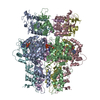+Search query
-Structure paper
| Title | Staphylococcal self-loading helicases couple the staircase mechanism with inter domain high flexibility. |
|---|---|
| Journal, issue, pages | Nucleic Acids Res, Vol. 50, Issue 14, Page 8349-8362, Year 2022 |
| Publish date | Aug 12, 2022 |
 Authors Authors | Cuncun Qiao / Gianluca Debiasi-Anders / Ignacio Mir-Sanchis /  |
| PubMed Abstract | Replication is a crucial cellular process. Replicative helicases unwind DNA providing the template strand to the polymerase and promoting replication fork progression. Helicases are multi-domain ...Replication is a crucial cellular process. Replicative helicases unwind DNA providing the template strand to the polymerase and promoting replication fork progression. Helicases are multi-domain proteins which use an ATPase domain to couple ATP hydrolysis with translocation, however the role that the other domains might have during translocation remains elusive. Here, we studied the unexplored self-loading helicases called Reps, present in Staphylococcus aureus pathogenicity islands (SaPIs). Our cryoEM structures of the PriRep5 from SaPI5 (3.3 Å), the Rep1 from SaPI1 (3.9 Å) and Rep1-DNA complex (3.1Å) showed that in both Reps, the C-terminal domain (CTD) undergoes two distinct movements respect the ATPase domain. We experimentally demonstrate both in vitro and in vivo that SaPI-encoded Reps need key amino acids involved in the staircase mechanism of translocation. Additionally, we demonstrate that the CTD's presence is necessary for the maintenance of full ATPase and helicase activities. We speculate that this high interdomain flexibility couples Rep's activities as initiators and as helicases. |
 External links External links |  Nucleic Acids Res / Nucleic Acids Res /  PubMed:35871290 / PubMed:35871290 /  PubMed Central PubMed Central |
| Methods | EM (single particle) |
| Resolution | 3.1 - 3.96 Å |
| Structure data | EMDB-12975, PDB-7ola: EMDB-12982, PDB-7om0:  EMDB-12987: Structure of Rep protein in SaPI1 EMDB-13342, PDB-7pds:  EMDB-13945: Rep-apo |
| Chemicals |  ChemComp-ANP:  ChemComp-MG:  ChemComp-AGS: |
| Source |
|
 Keywords Keywords | REPLICATION / Helicase / DNA binding / AMPPNP / SaPI1 |
 Movie
Movie Controller
Controller Structure viewers
Structure viewers About Yorodumi Papers
About Yorodumi Papers










